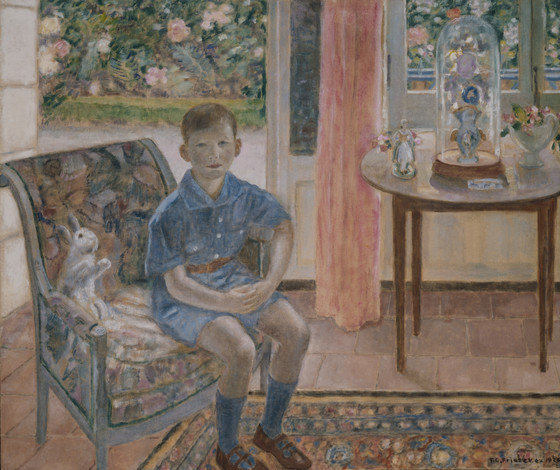This charming painting of a boy with his stuffed rabbit is a portrait of Preston Carter Harrison (born about 1921), son of Mr. and Mrs. William Preston Harrison....
This charming painting of a boy with his stuffed rabbit is a portrait of Preston Carter Harrison (born about 1921), son of Mr. and Mrs. William Preston Harrison. No doubt Preston Harrison chose Frieseke to paint the portrait on the advice of his artist-friends; indeed, Harrison records in a letter dated June 5, 1926, that Ernest Lawson (1873-1939) thought Frieseke the "greatest of all to paint youngsters." This sentiment was expressed to Harrison when the collector visited New York on his way to France. Frieseke painted the portrait a few weeks later at his summer home in Le-Mesnil-sur-Blangy. The Harrisons arrived there in late July, and by August 12 Harrison could write to Louise Upton at the museum that the portrait was completed.
Harrison was quite satisfied with the finished painting, considering it not only a typical Frieseke but a painting worthy of being in the museum. It combined the best of Frieseke’s talents, being a figure painting to which natural light is essential. Young Carter sits politely on the edge of an elegant French chair, obviously posing for the artist and oblivious to the sunlight filtering into the room through the windows and door. The sun’s intense rays contrast with the soft interior light. The pastel palette used to describe the scene is unlike that of most late works by Frieseke, which are delicate but usually darker. In fact, although Frieseke completed the painting, it appears almost unfinished. Despite the delicate effect, the painting has a strong structure organized by the lines of the room and the placement of the furniture. The variety of decorative patterns within the composition do not confuse the legibility of the scene, and, in fact, the patterned objects -- upholstered chair, oriental rug, and garden flowers in the distance -- form a contrast with the figure of the quiet boy. Harrison entitled the painting Youth rather than identifying it as a portrait of his son to avoid the type of criticism that the portrait of Mrs. Harrison by ROBERT HENRI, 1925 (LACMA; q.v.), had received.
More...



